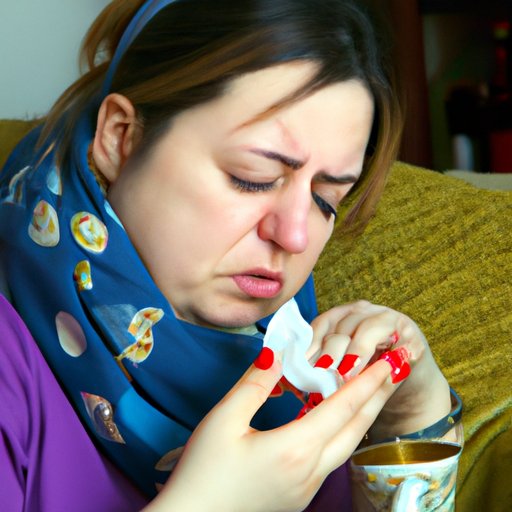
Introduction
Head colds are one of the most common illnesses that people experience, and they can be incredibly disruptive to daily life. Whether you’re feeling congested, have a sore throat, or just generally feel run down, a head cold can make it difficult to focus on your regular activities.
In this article, you’ll discover everything you need to know about head cold symptoms, including how to recognize them, the differences between a cold and the flu, and how you can treat them at home.
Signs and Indications: How to Recognize a Head Cold
The most common symptoms of a head cold include:
- Congestion or stuffy nose
- Runny nose
- Sore throat
- Cough
- Headache
- Mild fever
It’s important to note that not all head colds are created equal, and some may present with different symptoms. However, if you’re experiencing any of these symptoms, it’s likely that you have a head cold.
It’s also important to recognize that while some of these symptoms might be associated with other illnesses, such as the flu or allergies, there are some key differences between each of these conditions.
Is it a Cold or the Flu? Understanding the Symptoms of a Head Cold
The flu and the common cold are both caused by viruses that affect the respiratory system. However, there are several key differences between the two illnesses:
- The flu typically comes on more suddenly than a cold
- The flu is often accompanied by a high fever
- The flu tends to cause more severe symptoms, such as vomiting and diarrhea
- A cold is more likely to present with a runny or stuffy nose
It’s important to note that while the symptoms of both illnesses can be uncomfortable, the flu can be more serious, particularly in young children, the elderly, and those with compromised immune systems.
If you’re unsure whether you have a head cold or the flu, a doctor can perform a physical examination and run tests to make the appropriate diagnosis.
The Common Cold: Spotting its Symptoms and How to Treat It
The common cold is characterized by upper respiratory symptoms, such as congestion, cough, and sore throat. While colds can be uncomfortable, they usually resolve on their own within a week or two.
Traditional home treatments for the common cold include:
- Rest
- Hydration, such as drinking plenty of water and herbal tea
- Over-the-counter medications, such as decongestants or pain relief medication
While these treatments can provide relief for some cold symptoms, there is no cure for the common cold. Instead, the goal of treatment is to alleviate uncomfortable symptoms and support the body as it fights off the virus.
Feeling Crummy? Identifying Head Cold Symptoms and Getting Relief
There are several home remedies and treatments that can provide relief from head cold symptoms:
- Drinking warm fluids, such as tea or broth
- Steam therapy, such as taking a hot shower or inhaling steam from a bowl of hot water
- Using saline sprays or nasal rinses to alleviate congestion
- Gargling with salt water to ease a sore throat
In addition to these treatments, it’s important to get plenty of rest and stay hydrated to support your body as it fights off the virus. If your symptoms are severe or persistent, it’s important to see a doctor to rule out any other underlying conditions.
What You Need to Know about Head Colds: Recognizing Symptoms and Preventing the Spread
Head colds are highly contagious, and they can be spread through respiratory droplets when an infected person coughs or sneezes.
To prevent the spread of head colds, it’s important to:
- Cover your mouth and nose when coughing or sneezing
- Wash your hands frequently
- Avoid contact with others if you’re sick
In addition to these measures, it’s important to maintain healthy lifestyle habits, such as eating a balanced diet and getting enough exercise, to support your overall immune system and reduce your risk of head colds in the future.
Head Cold Got You Down? Here’s How to Tell You Have One and What to Do About It
If you’re experiencing head cold symptoms, it’s important to rest and stay hydrated to support your body as it fights off the virus.
Home remedies, such as warm fluids and steam therapy, can provide relief from uncomfortable symptoms. However, if your symptoms are severe or persistent, it’s important to see a doctor to rule out any underlying conditions.
With the right combination of rest, hydration, and self-care, you can help alleviate head cold symptoms and feel better in no time.
Head Cold Diagnosis: How to Identify the Symptoms and Determine the Best Treatment
If you’re experiencing severe symptoms or if your symptoms persist for more than a week, it’s important to see a doctor. A doctor can perform a physical examination and run tests to determine if there’s an underlying infection or condition that’s causing your symptoms.
Treatment for head colds may include prescription medication, depending on the severity of your symptoms. Your doctor can provide specific recommendations for treatment based on your individual health history and symptoms.
Conclusion
Head colds are a common part of life, and while they can be uncomfortable, they usually resolve on their own within a week or two. By recognizing the symptoms of a head cold and taking steps to prevent the spread of infection, you can help protect yourself from future illnesses.
If you’re experiencing head cold symptoms, it’s important to get plenty of rest and stay hydrated to support your body. And if your symptoms persist or are severe, don’t hesitate to see a doctor for diagnosis and treatment.




